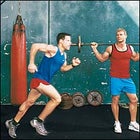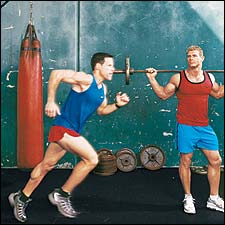IF YOU WANT TO ENSURE a great summer of cycling or running, we've got one piece of advice: Lose ten pounds this winter. Shaving body weight is the easiest way to add kick to your game come Memorial Day. By that time, your lighter (and dare we say sexier) bod will be faster and sleeker—and primed for its best season of action.
lose ten pounds

The most famous example of the leaner-equals-meaner mantra is Lance Armstrong, who lost more than 20 pounds as a result of cancer treatments. That drop helped make him faster in the end. But you probably don't have to lose that much.
A better example comes from another legendary cyclist, Miguel Indurain. In the fall of 1990, the six-foot-two-inch Spanish rider weighed a muscular 184 pounds—too heavy to stay competitive in the mountain stages of the Tour de France. But that winter, a consultant to Indurain's team, Max Testa, now director of sports performance at the University of California at Davis, figured out the optimal ratio of power to body weight for cyclists, based on his studies of past Tour winners (see “The Golden Ratio,” below). To reach it, Indurain had to shed only 12 pounds. Which he did. The next year he won his first of five consecutive Tours.
Like cyclists, runners also benefit from going lean. “Any extra flab is dead weight that isn't going to help you generate accelerating force,” says Tom Osler, author of The Serious Runner's Handbook. To make his case, Osler analyzed 40 years of data from 1,800 races, ranging from 5Ks to marathons, and found that, on average, every extra pound of body fat costs 2.5 seconds per mile. Drop ten pounds and, over the course of a marathon, you'll shave close to 11 minutes off your time.
NOW, DON'T FREAK OUT. We're not suggesting you go on a crash diet à; la Bill Clinton. In fact, assuming you already have a decent exercise regimen and eat right, taking off a ten-spot doesn't require any extra sweat. (But make sure that weight loss is real, not just fleeting water loss.)
All you need to do is make small changes in how and when you eat (see “Your Loss Is Your Gain,” ). But you have to start now—winter is the ideal season for dropping the lard. “Trying to lose weight while you're training hard during the late spring and over the summer will impair your ability to build strength and speed when you need it most,” says David Costill, the recently retired director of the human-performance lab at Indiana's Ball State University.
With this in mind, make it your goal to arrive at your trimmer self two months before any big event you've got inked in for the summer. “That way, you'll be able to get the most out of those two months of training,” says Costill. Losing ten pounds can make you faster, but you still have to work to make yourself fast.
The Golden Ratio » A potential world champion in an endurance sport like cycling needs to maintain a power output of 2.7 watts per pound of body weight for 45 minutes. (Which, coincidentally, is believed to be Lance Armstrong's output during a mountain climb in the Tour de France.) Mere recreational mortals should consider themselves optimally fit once they attain a more down-to-earth ratio of 1.6 watts per pound of body weight. Translated, this means a 170-pound athlete should be able to pump out an average of 272 watts over 45 minutes. And remember: The more weight you lose, the easier it will be to hit the target ratio—a 160-pounder's goal is a more reasonable 254 watts. To find out your current ratio, hop on any treadmill or stationary bike that measures watts, go as hard as you can for 45 minutes, then do the math.
Your Loss Is Your Gain
Five easy ways to trim the fat
LESS MASS MAKES YOU FAST:
A ten-pound weight loss saves…*…A RUNNER 2:10 in a 10K race
…A CYCLIST 0:51 on a 3.1-mile, 7-percent-grade hill climb
…A HIKER 5:00 on a 6.2-mile, 7-percent-grade hill climb
*Based on a moderately fit 170-pound person
1.) WORK OUT BEFORE BREAKFAST
“It's a fact that you burn a greater percentage of fat before eating breakfast,” says Monique Ryan, sports nutritionist and author of Sports Nutrition for Endurance Athletes (Velo Press). “A moderate 30-minute exercise session, or even a brisk walk, is all you need to draw on your fat stores to fuel your activity and spark your metabolism.”
2.) LEARN TO LOVE DAIRY
Replacing three or four servings of meats and starches with non- or low-fat servings of yogurt, cheese, or milk each day can help you lose an average of 15 pounds over the course of a year, according to Robert P. Heaney, professor of medicine at Creighton University, in Omaha, Nebraska. The secret? Naturally occurring calcium, which induces the body to metabolize fat more efficiently.
3.) AVOID LIQUID CALORIES
A sugar-packed soda won't make you feel as full as a piece of fruit will. With the exception of milk, liquid calories don't cause your body to register a sense of fullness; as a result, you stay hungrier, consume more calories than you need, and gain more weight.
4.) WALK AFTER DINNER
“A 20-minute stroll immediately after polishing off dessert, while slow enough not to interfere with digestion, burns up to 100 calories and reduces the amount of fat-promoting insulin released into your body,” says Carl Foster, a professor in the department of exercise and sports science at the University of Wisconsin–La Crosse.
5.) LATE NIGHT? EAT MEAT
For a midnight snack, grab a piece of protein-rich turkey, not an orange or a slice of toast. The sugar and carbs in the latter two stimulate the production of insulin, changing the way your liver processes glucose, turning it into fat.


